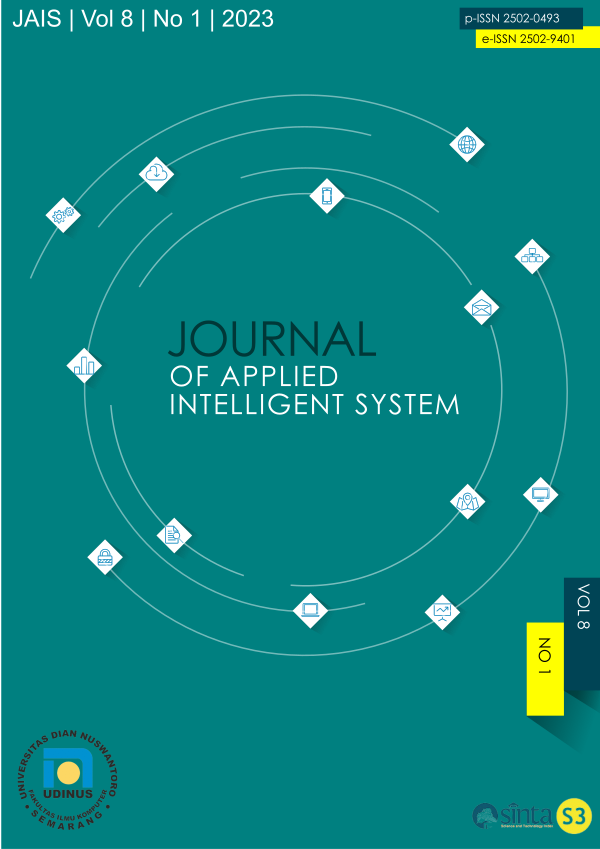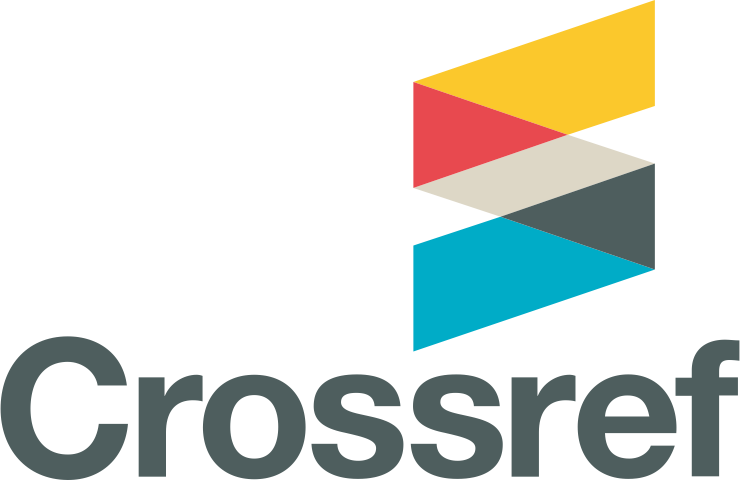Improvement of Data Mining Models using Forward Selection and Backward Elimination with Cryptocurrency Datasets
DOI:
https://doi.org/10.33633/jais.v8i1.7568Abstract
Cryptocurrency is a digital currency not managed by a state or central bank, and transactions are peer-to-peer. Cryptocurrency is still considered a speculative asset and its price volatility is relatively high, but it is also expected to become an efficient and secure transaction tool in the future. The purpose of this study is to compare and improve the performance of the Data Mining Algorithm model using the Feature Selection-Wrapper with the Binance Coin (BNB) cryptocurrency dataset. The Feature Selection-Wrapper approach used is Forward Selection and Backward Elimination. The algorithms used are Neural Networks, Deep Learning, Support Vector Machines, and Linear Regression. The methodology used is Knowledge Discovery in Databases. The results showed that from a comparison using K-Fold Cross Validation with a value of K=10, the Neural Network Algorithm has the best Root Mean Square Error value of 10,734 +/- 10,124 (micro average: 14,580 +/- 0,000). Then after improving performance using Forward Selection and Backward Elimination in the Neural Network Algorithm, the best performance improvement results are shown by using Backward Elimination with RMSE 5,302 +/- 2,647 (micro average: 5,805 +/- 0,000).References
P. Katsiampa, L. Yarovaya, and D. Zi, “Journal of International Financial Markets , High-frequency connectedness between Bitcoin and other top-traded crypto assets during the COVID-19 crisis,” vol. 79, no. November 2021, 2022, doi: 10.1016/j.intfin.2022.101578.
F. Xu, E. Bouri, and O. Cepni, “Blockchain and crypto-exposed US companies and major cryptocurrencies : The role of jumps and co-jumps,” Financ. Res. Lett., vol. 50, no. April, p. 103201, 2022, doi: 10.1016/j.frl.2022.103201.
K. Vikram, N. Sivaraman, and D. P. Balamurugan, “Crypto Currency Market Price Prediction Using Data Science Process,” Int. J. Res. Appl. Sci. Eng. Technol., vol. 10, no. 2, pp. 1451–1454, 2022, doi: 10.22214/ijraset.2022.40521.
Y. Wei, Y. Wang, B. M. Lucey, and S. A. Vigne, “Cryptocurrency Uncertainty and Volatility Forecasting of Precious Metal Futures Markets,” J. ofCommodityMarkets J., vol. 29, pp. 1–16, 2023.
P. Solana, F. Orte, and M. J. S, “A Random Forest-Based Model for Crypto Asset Forecasts in Futures Markets with out-of-Sample Prediction,” Res. Int. Bus. Financ., vol. 64, no. November 2022, pp. 1–29, 2023, doi: 10.1016/j.ribaf.2022.101829.
I. T. Julianto, D. Kurniadi, M. R. Nashrulloh, and A. Mulyani, “Comparison Of Data Mining Algorithm For Forecasting Bitcoin Crypto Currency Trends,” JUTIF, vol. 3, no. 2, pp. 245–248, 2022.
D. T. Larose and C. D. Larose, Discovering Knowledge in Data. 2014.
C. C. Aggarwal, Data Mining : The Textbook. New York: Springer, 2015.
A. S. Yudistira and A. Nugroho, “Prediction Of The English Premier League Champion Team For The 2021 / 2022 Season Using The Naïve Bayes Method,” JUTIF, vol. 3, no. 5, pp. 1239–1243, 2022.
Z. R. S. Elsi et al., “Utilization of Data Mining Techniques in National Food Security during the Covid-19 Pandemic in Indonesia,” J. Phys. Conf. Ser., pp. 1–7, 2020, doi: 10.1088/1742-6596/1594/1/012007.
A. A. Argasah and D. Gustian, “Data Mining Analysis To Determine Employee Salaries According To Needs Based On The K-Medoids Clustering Algorithm Analisis Data Mining Untuk Menentukan Gaji Karyawan Sesuai Penilaian Kemampuan Menggunakan Algoritma K-Medoids,” JUTIF, vol. 3, no. 1, pp. 29–35, 2022.
A. R. Muhajir, E. Sutoyo, and I. Darmawan, “Forecasting Model Penyakit Demam Berdarah Dengue Di Provinsi DKI Jakarta Menggunakan Algoritma Regresi Linier Untuk Mengetahui Kecenderungan Nilai Variabel Prediktor Terhadap Peningkatan Kasus,” Fountain Informatics J., vol. 4, no. 2, pp. 33–40, 2019.
I. Ubaedi and Y. M. Djaksana, “Optimasi Algoritma C4.5 Menggunakan Metode Forward Selection Dan Stratified Sampling Untuk Prediksi Kelayakan Kredit,” JSiI (Jurnal Sist. Informasi), vol. 9, no. 1, pp. 17–26, 2022, doi: 10.30656/jsii.v9i1.3505.
W. Nugroho, “Optimasi Metode K-Nearest Neighbours dengan Backward Elimination Menggunakan Dataset Software Effort Estimation,” Bianglala Inform., vol. 8, no. 2, pp. 129–133, 2020.
I. R. Amilia, H. Oktavianto, and G. Abdurrahman, “Penerapan Backward Elimination Untuk Seleksi Fitur Pada Algoritma K-Nearest Neighbor Untuk Klasifikasi Penyakit Gagal Jantung,” J. Smart Teknol., vol. 1, no. 1, pp. 1–9, 2021.
Yunitasari, H. S. Hopipah, and R. Mayasari, “Optimasi Backward Elimination untuk Klasifikasi Kepuasan Pelanggan Menggunakan Algoritme k-nearest neighbor (k-NN) and Naive Bayes,” Technomedia J., vol. 6, no. 1, pp. 99–110, 2021, doi: 10.33050/tmj.v6i1.1531.
M. A. Wiratama and W. M. Pradnya, “Optimasi Algoritma Data Mining Menggunakan Backward Elimination untuk Klasifikasi Penyakit Diabetes,” J. Nas. Pendidik. Tek. Inform., vol. 11, no. 1, pp. 1–12, 2022, doi: 10.23887/janapati.v11i1.45282.
I. T. Julianto, “Design And Build Virtual Reality Photography Web-Based To Support Tourism,” J. Electr. Electron. Information, Commun. Technol., vol. 3, no. 2, p. 58, Oct. 2021, doi: 10.20961/jeeict.3.2.54833.
I. T. Julianto, D. Kurniadi, M. R. Nashrulloh, and A. Mulyani, “Comparison Of Classification Algorithm And Feature Selection In Perbandingan Algoritma Klasifikasi Dan Feature Selection,” JUTIF, vol. 3, no. 3, pp. 739–744, 2022.
I. T. Julianto, D. Kurniadi, M. R. Nashrulloh, and A. Mulyani, “Data Mining Algorithm Testing For SAND Metaverse Forecasting,” J. Appl. Intell. Syst., vol. 7, no. 3, pp. 259–267, 2022.
yahoo finance, “BNB USD (BNB-USD),” yahoo.finance.com, 2023. https://finance.yahoo.com/quote/BNB-USD/history?period1=1500940800&period2=1674086400&interval=1mo&filter=history&frequency=1mo&includeAdjustedClose=true.
Mikhael, F. Andreas, and U. Enri, “Perbandingan Algoritma Linear Regression, Neural Network, Deep Learning, Dan K-Nearest Neighbor (K-Nn) Untuk Prediksi Harga Bitcoin,” JSI J. Sist. Inf., vol. 14, no. 1, pp. 2450–2464, 2022, [Online]. Available: http://ejournal.unsri.ac.id/index.php/jsi/index.
Han and Kamber, Data Mining Concepts and Technique. San Francisco: Diane Cerra, 2006.
D. Kurniadi, F. Nuraeni, and S. M. Lestari, “Implementasi Algoritma Naïve Bayes Menggunakan Feature Forward Selection dan SMOTE Untuk Memprediksi Ketepatan Masa Studi Mahasiswa Sarjana,” J. Sist. Cerdas, vol. 05, no. 02, pp. 63–82, 2022.
F. I. Sanjaya and D. Heksaputra, “Prediksi Rerata Harga Beras Tingkat Grosir Indonesia dengan Long Short Term Memory,” JATISI (Jurnal Tek. Inform. dan Sist. Informasi), vol. 7, no. 2, pp. 163–174, 2020, doi: 10.35957/jatisi.v7i2.388.
T. Sellar and A. A. Arulrajah, “The Role of Social Support on Job Burnout in the Apparel Firm,” Int. Bus. Res., vol. 12, no. 1, p. 110, 2018, doi: 10.5539/ibr.v12n1p110.
Downloads
Published
Issue
Section
License
- Authors retain copyright and grant the journal right of first publication with the work simultaneously licensed under a Creative Commons Attribution License that allows others to share the work with an acknowledgment of the work's authorship and initial publication in this journal.
- Authors are able to enter into separate, additional contractual arrangements for the non-exclusive distribution of the journal's published version of the work (e.g., post it to an institutional repository or publish it in a book), with an acknowledgment of its initial publication in this journal.
- Authors are permitted and encouraged to post their work online (e.g., in institutional repositories or on their website) prior to and during the submission process, as it can lead to productive exchanges, as well as earlier and greater citation of published work (See The Effect of Open Access).









